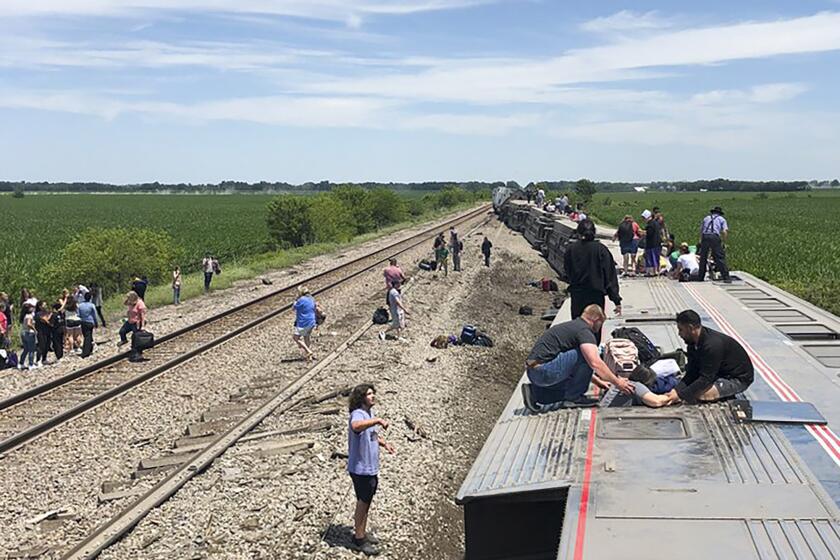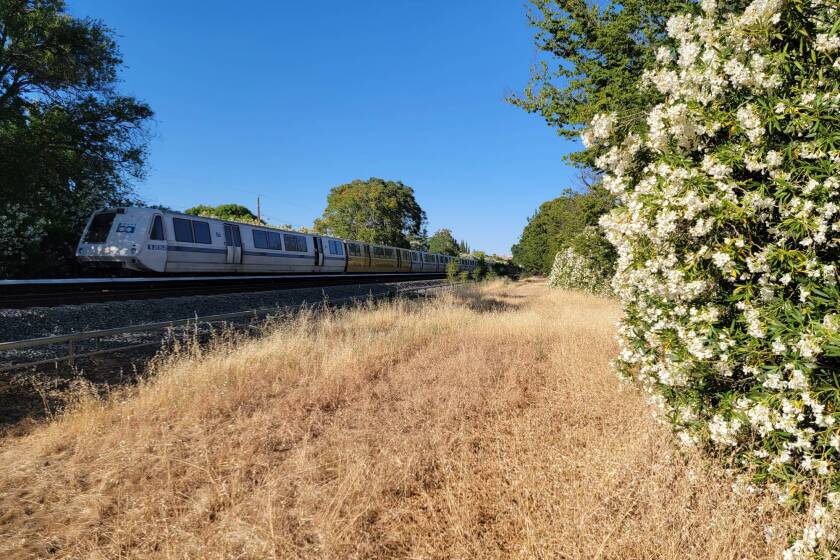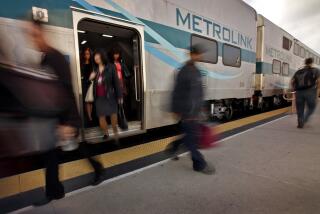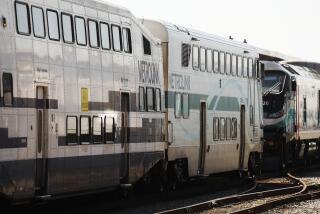Railway crossing under investigation in Missouri Amtrak crash
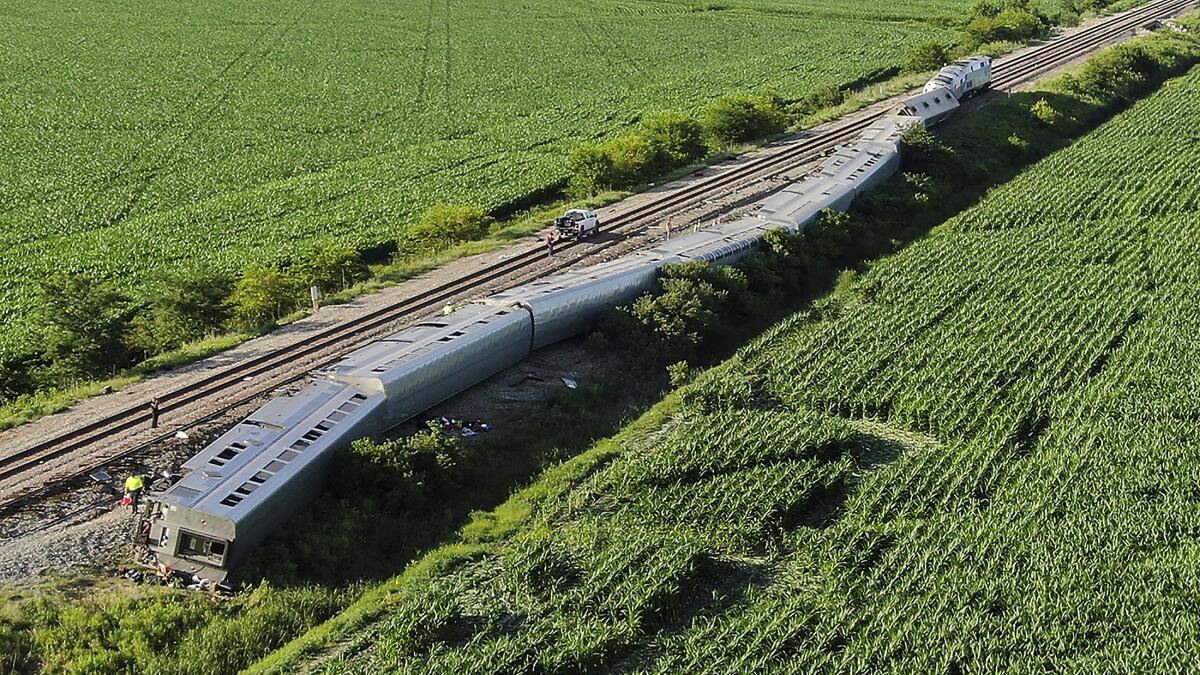
- Share via
The four people who were killed in the Amtrak crash Monday in rural Missouri were identified Wednesday, days after the train crashed into a dump truck, derailing the entire train.
Rochelle Cook, 57, and Kim Holsapple, 56, both of Desoto, Kan., and passengers on the train, were pronounced dead at the scene Monday, as was the dump truck’s driver, 53-year-old Billy Barton II, of Brookfield, Mo., according to the Missouri State Highway Patrol. A third train passenger, Binh Pham, 82, of Kansas City, also died Monday, but after being transported to the University Hospital in Columbia, officials said.
More than 150 other people, with injuries ranging from minor to severe, were taken for treatment to 10 different area hospitals, officials said.
The Southwest Chief train, headed from Los Angeles to Chicago with 275 passengers and 12 crew members, plowed into the truck near the town of Mendon, northwest of Columbia, at a gravel road’s railway crossing, unmarked by electronic signals or crossing arms.
National Transportation Safety Board officials said Tuesday the federal investigation into the crash will focus on the railway’s crossing — which had been slated for improvements and become a safety concern for local farmers.
The train, with 243 passengers and 12 crew members, derailed Monday in Mendon, Mo., after hitting a truck, Amtrak said in a statement.
Officials said the deadly collision was not likely related to mechanical or track issues.
Just before 1 p.m. Monday, the Amtrak train struck the back of the dump truck in the rural railway intersection, derailing all eight cars of the train and its two locomotives, NTSB Chair Jennifer Homendy said at a Tuesday press conference. The truck was delivering rocks to a local Army Corps of Engineers project, she said.
Homendy said the intersection is a “passive grade crossing,” meaning it did not include warning lights, bells or crossing bars but only signage for oncoming drivers. She said about 50% of the 130,000 railway crossings in the U.S. are considered passive.
“The NTSB has issued recommendations for a number of years on either closing crossings, consolidating crossings, separating grade crossings and making grade crossings that are not separated or consolidated active crossings so that there are gates, bells and whistles to provide warning to drivers that approach crossings,” Homendy said.
It’s unclear to what extent those recommendations have been acted upon in Missouri and across the U.S., but Missouri Department of Transportation officials confirmed upgrades had not yet been implemented for the railway crossing at the site of this week’s crash.
Drivers approaching the rural crossing in Missouri’s Chariton County would see two black-and-white X-shaped signs, called crossbucks, that often read “railroad crossing,” officials said.
The location was identified for upgrades this year, which could include lights, gates and other roadway improvements, at a cost of $400,000, according to an infrastructure plan published this year by the Missouri Department of Transportation. But department spokesperson Linda Horn said the project had not yet begun.
She said state transportation officials were still working with the private railway operator, BNSF Railways, and local officials to “develop an agreed-upon solution and schedule,” then would need to hire a contractor to complete the work.
According to a report from the Kansas City Star, farmers in the area had voiced concerns about the railway crossing but to no avail. They said the approach was too steep and the brush was difficult to see around, and they had asked for improved signals.
Missouri has 3,311 railway crossings, and about half are considered passive, or without lights, Horn said.
Homendy also said that the NTSB made recommendations in 1998 about improving technology in vehicles to better alert drivers of trains or approaching crossings, but that has also not been realized.
“It’s been 24 years and that recommendation is still as important today as it was in 1998,” Homendy said. “Lives could be saved. ... It’s very frustrating for our investigators when they are on scene and they know what could have prevented this.”
Homendy said her team of 15 investigators will review the train’s event recorder, which will provide information on the train’s speed, braking and signaling — such as whether the horn blew — as well as the train’s two forward-facing cameras. They will also review whether any such information is available for the truck. Amtrak and BNSF are supporting the investigation, she said.
The NTSB’s mission is to understand “what happened, why it happened and to prevent recurrence of that issue in the future,” Homendy said. “To the families that lost loved ones in this tragedy, we extend our deepest condolences. To the survivors … we will think of you in the weeks, days, months to come.”
She also thanked two Boy Scout troops that were on the train, traveling back to Wisconsin, who helped in the emergency response.
Attorney Robert J. Mongeluzzi, who has represented victims in other Amtrak crashes, said the NTSB investigators will “focus on every safety factor, eventually determining if this was a predictable and preventable incident.”
“Passengers and the general public must be assured that the Amtrak system, including rail crossings coast to coast, is safe,” Mongeluzzi said. “We know from years of experience that properly operated trains and maintained track should not be involved in these kinds of incidents.”
While the roadway where the crash occurred is unpaved and in a rural area, Missouri Highway Patrol Cpl. Justin Dunn said it’s wide enough for two-way traffic. Photos shared from the Missouri Highway Patrol after the derailment showed a line of cars, including a truck and school bus, on both sides of the intersection with the railway.
The crash came one day after another Amtrak train collided with a car in California’s East Bay, also at a rural railroad crossing, killing three people. Eighty-five people were on the train, which was traveling from Stockton to Martinez. There were no reported injuries among the train passengers and crew, officials said.
“Sadly, despite its history, Amtrak has yet to create a culture where safety is its highest priority,” said Jeffrey Goodman, Mongeluzzi’s partner.
Goodman and Mongeluzzi represented victims in the 2015 derailment of an Amtrak train in Philadelphia that killed eight people, the 2021 derailment of an Amtrak train in Montana that killed three and other fatal crashes in Georgia, Pennsylvania and New Jersey.
Temperatures on the track exceeded 140 degrees — about 35 degrees above the rail’s ordinary operating temperature — a BART spokesman said.
The location of the Sunday crash in East Bay was also in a rural area, where an unpaved road crosses the railway tracks without electronic signals or crossing arms, said Steve Aubert, the fire marshal with the East Contra Costa Fire Protection District. He said that stretch of the road mainly connects private property to paved roads, so there’s limited traffic. But in that area, the trains are allowed to travel up to 80 mph through the mostly farmland.
“That fast — it’s going to take them a mile and a half to even stop,” Aubert said. He said there is a sign marking the railroad crossing, but not much else.
“No guards, no signals, no nothing,” Aubert said. “They look at how much traffic crosses over in one section like that, and it’s a cost-prohibitive kind of thing.”
He said his agency responds to a train and vehicle crash once or twice a year, typically involving an agricultural truck that can’t move too fast, though it’s rarely fatal.
But there are often safety issues at both types of these railroad crossings — those with and without electronic signals or crossing arms, said Nancy Sheehan, executive director of California Operation Lifesaver, a nonprofit that focuses train safety education.
“Trains may be moving faster than you think, so we recommend always at those crossings to wait for the train to pass, then, again, look both ways,” Sheehan said.
She said people often expect to hear trains coming, but upgraded technology has changed the noise of many trains.
“You want to make sure you’re both looking and listening for a train,” Sheehan said. “Stay alert, be aware and always expect a train.”
According to the Federal Railroad Administration, there were 2,148 highway-rail grade crossing collisions across the U.S. in 2021, causing 236 deaths and 662 injuries. These incidents, though, have long been on a downward trend. In 1981, there were more than 700 such deaths.
More to Read
Sign up for Essential California
The most important California stories and recommendations in your inbox every morning.
You may occasionally receive promotional content from the Los Angeles Times.
